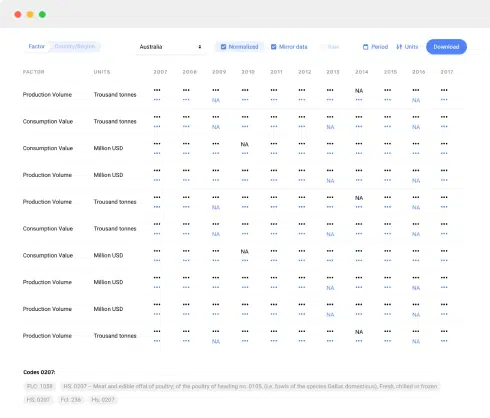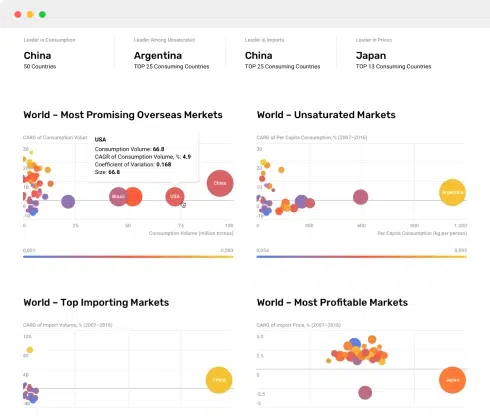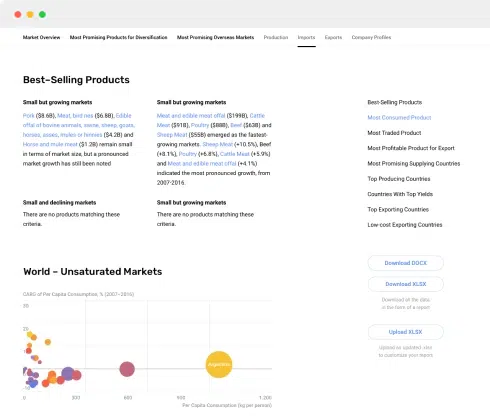
Purina ONE and Hills Science Diet Dominate 31% of Premium Segment, Royal Canin Commands +50% Price Premium with Elasticity of -8%
The pet food market is experiencing robust growth, fueled by increasing pet humanization and premiumization trends, with e-commerce becoming a dominant channel. This analysis leverages marketplace data to decode competitive positioning, pricing strategies, and consumer sentiment for leading cat and dog food brands. Understanding these dynamics is critical for manufacturers and retailers to optimize assortment, pricing, and marketing investments in a highly competitive landscape. The insights provided are essential for strategic planning and maintaining a competitive edge.
Methodology
The analysis is based on data aggregated by IndexBox monitoring tools from the Amazon marketplace in the United States, with delivery parameters set to ZIP code 60007. This specific geographic selection provides a focused view of availability, logistics, and pricing in a key consumer region. The data was collected for the "Cat and Dog Food" category using relevant search keywords. The full dataset and brand-level details are available on the IndexBox platform: https://app.indexbox.io/brands/2309/840.
Rating vs Reviews: Brand Perception Quadrants
- Star Brands (High Rating/High Reviews): Royal Canin and Blue Buffalo represent the ideal quadrant, combining strong consumer trust with high visibility. Their strategy should focus on maintaining quality and leveraging social proof to justify premium pricing and defend market share against new entrants.
- Rising Brands (Low Rating/High Reviews): Purina Pro Plan and Wellness have significant market presence but lower satisfaction scores, indicating potential quality or expectation mismatches. Immediate action should include deep analysis of negative feedback, product reformulation, and proactive review management to convert volume into loyalty.
- Niche Brands (High Rating/Low Reviews): Hills Science Diet and IAMS excel in quality but lack broad awareness, operating in a specialist or veterinary segment. Marketing efforts must focus on targeted digital campaigns, influencer partnerships with veterinarians, and sampling to drive review volume and break into the mainstream.
- Problematic Brands (Low Rating/Low Reviews): Brands like Purina ONE face the dual challenge of poor perception and low engagement. A fundamental reassessment of product-market fit is required, potentially coupled with aggressive promotional pricing to generate trials and gather crucial feedback for improvement.
Price vs Sales Volume: Strategic Positioning
- Premium/Low Volume (Royal Canin, Purina Pro Plan): These brands command high prices but have lower sales velocity, typical of a premium, margin-focused strategy. They should explore limited-time offers and smaller pack sizes to reduce the entry barrier for new customers without diluting the brand's premium image.
- Value/High Volume (Pedigree, Nutrish): This cluster dominates volume through aggressive pricing, appealing to price-sensitive segments. To protect margins, they should implement bundle promotions and cost-optimization programs while cautiously exploring minor price increases to gauge elasticity.
- Mass Premium (Purina ONE, Hills Science Diet): Occupying the high-volume and mid-to-high price quadrant, these brands successfully balance mass appeal with premium perception. Their strategy should be defended through continuous innovation, strong branding, and maximizing shelf presence and online visibility.
- Low Engagement (Blue Buffalo, Wellness): Despite mid-range pricing, these brands exhibit lower sales volume, suggesting a potential positioning or distribution issue. They need to reassess their channel strategy and enhance value communication to better connect with their target audience.
Price Distribution: Identifying Market Gaps
- The price distribution reveals a highly polarized market with concentrations in the value (<$20) and premium (>$35) segments, while the mid-range ($20-$35) is less crowded. This polarization reflects the prevailing market strategies of economy versus super-premiumization, leaving an opportunity for brands to capture the underserved mid-tier segment.
- The analysis identifies a "sweet spot" between $25-$32, where demand density remains high but competition is less intense. Brands should test targeted assortments within this range, as a ±5% price adjustment could significantly impact volume without triggering a price war with entrenched value or premium players.
- Notable anomalies include listings above $100, which may indicate limited-edition products, large multi-packs, or potential grey market imports. Monitoring these outliers is crucial for brand protection and understanding the absolute limits of price acceptance in the market.
Market Share: The Battle for Volume
- Purina ONE and Blue Buffalo collectively command a dominant share, indicating strong brand equity and distribution muscle. To maintain leadership, they must continuously innovate and leverage their scale for omnichannel marketing dominance, preventing smaller, agile brands from eroding their base.
- The long tail of the market ("Others") represents a significant competitive battlefield. Leaders should consider targeted acquisitions of emerging niche brands within this segment to acquire innovation and loyal customer bases, thereby diversifying their portfolio and mitigating risk.
- A comparison of market share against estimated marketing spend reveals that brands like Hills Science Diet achieve a strong position with a likely focused, high-ROI strategy (e.g., veterinary channel partnerships). This underscores the effectiveness of targeted, professional endorsement over broad-based consumer advertising for premium offerings.
Price Distribution: Assortment and Variability
- Royal Canin exhibits the widest price range and highest median price, reflecting a deep and diversified assortment catering to various breeds, life stages, and health conditions. This strategy effectively maximizes revenue across different consumer needs and price sensitivities within the premium tier.
- Significant overlap in the interquartile ranges of Blue Buffalo, Purina Pro Plan, and Wellness indicates intense direct competition in the mid-to-high price segment. Brands must differentiate through superior ingredients, clear functional benefits, and brand storytelling to avoid competing solely on price.
- The presence of high-value outliers for Royal Canin and Merrick points to successful ultra-premium or prescription lines. These products should be marketed separately to justify their price point, focusing on specific health outcomes and professional recommendations to avoid confusing the core brand positioning.
Competitive Strategies
| Strategy | Key Brands | Core Focus |
|---|---|---|
| Low-Cost Leadership | Pedigree, Nutrish | Maximizing volume through competitive pricing and economy offerings. |
| Premium Differentiation | Royal Canin, Hills Science Diet | Commanding price premiums through specialized formulas and veterinary endorsements. |
| Mass Premium | Purina ONE, IAMS | Balancing quality and affordability to capture the broad middle market. |
| Niche Focus | Wellness, Merrick | Targeting specific consumer values like natural ingredients or grain-free recipes. |
Actionable Intelligence with Custom Search
- The IndexBox platform's "Custom Search Request" panel enables on-demand, targeted data parsing to answer specific strategic questions. A marketing director can automate daily tracking of competitor discounting patterns and promotional calendars for key SKUs, transforming reactive tactics into a proactive strategy.
- This functionality allows for scenario testing, such as estimating the market share impact of a planned 10% price increase by analyzing historical elasticity data. The resulting data feeds can be integrated directly into BI dashboards, providing a live competitive intelligence stream for executive decision-making.
Conclusion
The cat and dog food market is strategically segmented between volume-driven value players and margin-rich premium brands, with the mid-market representing a key growth opportunity. Leaders must defend their positions through innovation and M&A, while challengers can succeed by dominating niche categories with authentic branding. For new entrants, the high barriers of established brand loyalty and distribution networks necessitate a highly focused, digitally-native launch strategy. Continuous monitoring through IndexBox is not an option but a necessity for navigating this dynamic and competitive landscape effectively.
1. INTRODUCTION
Making Data-Driven Decisions to Grow Your Business
- REPORT DESCRIPTION
- RESEARCH METHODOLOGY AND THE AI PLATFORM
- DATA-DRIVEN DECISIONS FOR YOUR BUSINESS
- GLOSSARY AND SPECIFIC TERMS
2. EXECUTIVE SUMMARY
A Quick Overview of Market Performance
- KEY FINDINGS
- MARKET TRENDSThis Chapter is Available Only for the Professional EditionPRO
3. MARKET OVERVIEW
Understanding the Current State of The Market and its Prospects
- MARKET SIZE: HISTORICAL DATA (2012–2024) AND FORECAST (2025–2035)
- MARKET STRUCTURE: HISTORICAL DATA (2012–2024) AND FORECAST (2025–2035)
- TRADE BALANCE: HISTORICAL DATA (2012–2024) AND FORECAST (2025–2035)
- PER CAPITA CONSUMPTION: HISTORICAL DATA (2012–2024) AND FORECAST (2025–2035)
- MARKET FORECAST TO 2035
4. MOST PROMISING PRODUCTS FOR DIVERSIFICATION
Finding New Products to Diversify Your Business
- TOP PRODUCTS TO DIVERSIFY YOUR BUSINESS
- BEST-SELLING PRODUCTS
- MOST CONSUMED PRODUCTS
- MOST TRADED PRODUCTS
- MOST PROFITABLE PRODUCTS FOR EXPORTS
5. MOST PROMISING SUPPLYING COUNTRIES
Choosing the Best Countries to Establish Your Sustainable Supply Chain
- TOP COUNTRIES TO SOURCE YOUR PRODUCT
- TOP PRODUCING COUNTRIES
- TOP EXPORTING COUNTRIES
- LOW-COST EXPORTING COUNTRIES
6. MOST PROMISING OVERSEAS MARKETS
Choosing the Best Countries to Boost Your Export
- TOP OVERSEAS MARKETS FOR EXPORTING YOUR PRODUCT
- TOP CONSUMING MARKETS
- UNSATURATED MARKETS
- TOP IMPORTING MARKETS
- MOST PROFITABLE MARKETS
7. PRODUCTION
The Latest Trends and Insights into The Industry
- PRODUCTION VOLUME AND VALUE: HISTORICAL DATA (2012–2024) AND FORECAST (2025–2035)
8. IMPORTS
The Largest Import Supplying Countries
- IMPORTS: HISTORICAL DATA (2012–2024) AND FORECAST (2025–2035)
- IMPORTS BY COUNTRY: HISTORICAL DATA (2012–2024)
- IMPORT PRICES BY COUNTRY: HISTORICAL DATA (2012–2024)
9. EXPORTS
The Largest Destinations for Exports
- EXPORTS: HISTORICAL DATA (2012–2024) AND FORECAST (2025–2035)
- EXPORTS BY COUNTRY: HISTORICAL DATA (2012–2024)
- EXPORT PRICES BY COUNTRY: HISTORICAL DATA (2012–2024)
10. PROFILES OF MAJOR PRODUCERS
The Largest Producers on The Market and Their Profiles
LIST OF TABLES
- Key Findings In 2024
- Market Volume, In Physical Terms: Historical Data (2012–2024) and Forecast (2025–2035)
- Market Value: Historical Data (2012–2024) and Forecast (2025–2035)
- Per Capita Consumption: Historical Data (2012–2024) and Forecast (2025–2035)
- Imports, In Physical Terms, By Country, 2012–2024
- Imports, In Value Terms, By Country, 2012–2024
- Import Prices, By Country, 2012–2024
- Exports, In Physical Terms, By Country, 2012–2024
- Exports, In Value Terms, By Country, 2012–2024
- Export Prices, By Country, 2012–2024
LIST OF FIGURES
- Market Volume, In Physical Terms: Historical Data (2012–2024) and Forecast (2025–2035)
- Market Value: Historical Data (2012–2024) and Forecast (2025–2035)
- Market Structure – Domestic Supply vs. Imports, in Physical Terms: Historical Data (2012–2024) and Forecast (2025–2035)
- Market Structure – Domestic Supply vs. Imports, in Value Terms: Historical Data (2012–2024) and Forecast (2025–2035)
- Trade Balance, In Physical Terms: Historical Data (2012–2024) and Forecast (2025–2035)
- Trade Balance, In Value Terms: Historical Data (2012–2024) and Forecast (2025–2035)
- Per Capita Consumption: Historical Data (2012–2024) and Forecast (2025–2035)
- Market Volume Forecast to 2035
- Market Value Forecast to 2035
- Market Size and Growth, By Product
- Average Per Capita Consumption, By Product
- Exports and Growth, By Product
- Export Prices and Growth, By Product
- Production Volume and Growth
- Exports and Growth
- Export Prices and Growth
- Market Size and Growth
- Per Capita Consumption
- Imports and Growth
- Import Prices
- Production, In Physical Terms: Historical Data (2012–2024) and Forecast (2025–2035)
- Production, In Value Terms: Historical Data (2012–2024) and Forecast (2025–2035)
- Imports, In Physical Terms: Historical Data (2012–2024) and Forecast (2025–2035)
- Imports, In Value Terms: Historical Data (2012–2024) and Forecast (2025–2035)
- Imports, In Physical Terms, By Country, 2024
- Imports, In Physical Terms, By Country, 2012–2024
- Imports, In Value Terms, By Country, 2012–2024
- Import Prices, By Country, 2012–2024
- Exports, In Physical Terms: Historical Data (2012–2024) and Forecast (2025–2035)
- Exports, In Value Terms: Historical Data (2012–2024) and Forecast (2025–2035)
- Exports, In Physical Terms, By Country, 2024
- Exports, In Physical Terms, By Country, 2012–2024
- Exports, In Value Terms, By Country, 2012–2024
- Export Prices, By Country, 2012–2024


